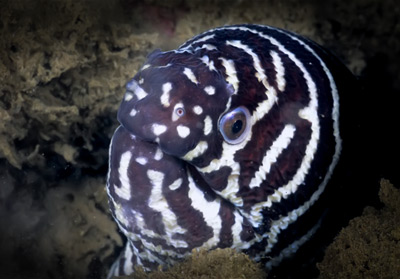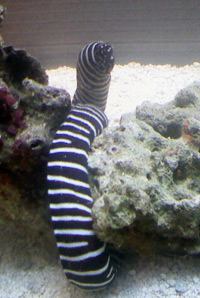On various occasions, I’ve written about my fondness for the snowflake moray eel (Echidna nebulosa), in one post even going so far as to claim there may be no better eel for the marine aquarium. My biases notwithstanding, I can’t deny that certain other morays make excellent aquarium candidates as well. Among them is the stunning zebra moray (Gymnomuraenea zebra), which has a pretty sterling reputation for being peaceful, hardy, adaptable, and generally safe around piscine tankmates.
Physical traits
As you might guess from its common name and specific epithet, G. zebra is brown overall with a series of vertical white to yellowish bands running the length of its body (or is it white to yellowish overall with vertical brown bands?). Typically eel-shaped, this species can reach a length of almost five feet—but that’s the record holder. Most specimens are unlikely to achieve that prodigious length. The teeth are blunt and molar-like and designed for crushing hard-shelled prey items, not sharp and needle-like for the purpose of snagging fish.
Feeding
In nature, G. zebra feeds primarily on crustaceans. Captive specimens can be taught to accept a variety of meaty food items, such as shrimp, clams, mussels, squid, etc. Feed no more than twice weekly. Presenting food items on a stick or with tongs is the best way to elicit a feeding response. Specimens that are reluctant to feed can often be enticed with live ghost shrimp.
Do not, however, hand feed your zebra moray. While possessing a powerful sense of smell, this species has notoriously poor eyesight and may mistake your digits for something edible. It may not have the sharpest teeth, but I still wouldn’t want that crushing force exerted on my fingers!
Housing
G. zebra doesn’t need much in the way of open swimming space, but it does require lots of rockwork to hide in and, as mentioned, is capable of reaching a rather respectable size. Thus, I would recommend a tank of at least 100 gallons for minimum housing. Also, be sure to cover the tank completely and tightly because, like any moray, this species can easily slither out of an open-topped tank or through an opening in the cover.
Compatibility
Obviously, crustaceans are best left out of a tank containing a zebra moray, but most fish will be fine with one. While many sources claim these morays can be trusted around small fish, I would advise against keeping bite-sized species as tankmates. I know I’m probably being overly conservative here, but it’s better to be safe than sorry in my opinion.
G. zebra won’t directly harm sessile invertebrates, but owing to its size, waste production, and potential for toppling aquascaping, I wouldn’t recommend one for most reef aquariums, with the possible exception of large systems with well-secured rockwork and corals.




